What are Meta Tags & Website Categories?
Meta tags are small bits of texts that describe a page’s content. These tags don’t appear on the webpage itself, but instead, they exist in the page’s code. Most people know of meta tags from the blogging world, where bloggers tag their articles with certain category tags they create.
The difference between these visible tags and meta tags is that meta tags exist purely in the HTML. Typically, they are at the beginning of the HTML, within the “head” of the page. Meta is short for ‘metadata’, and this data is about your page. This metadata, though, is only visible to search engines, or the person writing the HTML.

Below, I’m going to show you how you can grow your website using meta tags, categories, and Ezoic’s big data analytics tool.
Watch Tyler walk through how to do some of this in a recent episode of Ezoic Explains.
Do Meta tags help SEO?
Even in 2019, meta tags and descriptions still matter for SEO, but not all (and even most) can help you. Using meta tags won’t help you rank high in search if those meta tags aren’t accompanied buy high-quality content that centers on what’s most useful to your users.
With the meta tags written in your HTML, less is more. Moz’s Ultimate Guide to SEO Meta Tags says to stick to the core minimum, because less code is better. There are good meta tags and ones that can’t help you whatsoever. These “good” meta tags should be on every page, no matter what: Meta content type, meta title, meta description, and viewport.
Meta content type: Leaving out this meta tag could impact how your page renders in the browser. The good news is that the majority of site themes you are using on your CMS will include this information in the core code of your site. It should look something like this:
![]()
Meta title: The title tag doesn’t start with meta, but it’s still in the header and contains info that is important for your SEO. The title tag is on every page and it simply describes the page.
Meta description: These should be 160 characters or less and they serve one purpose: to describe your page to those searching for a query. This doesn’t affect your site ranking but it might affect whether users click on your site’s result. Yoast SEO’s WordPress plugin gives you the ability to edit your meta description without having to write it in your code.
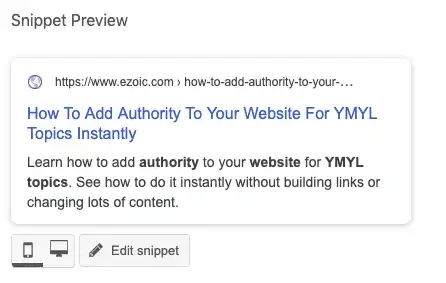
Viewport: Since the majority of web traffic is increasingly mobile, it’s a good idea to specify the viewport. If you don’t, you run the possibility of giving users a poor mobile experience. The standard meta tag is:
![]()
For the majority of publishers, those four key meta tags are the most important. But for publishers who use Ezoic, the Big Data Analytics tool offers the ability to create custom reporting using categories. This ability allows a publisher to create customized, categorical segments that help identify areas to potentially grow revenue.
How do I build Categories on my site?
If you want to be able to take advantage of custom segmenting with categories on Ezoic’s big data analytics, first you need to have categories set up on your website. This is typically done through your CMS of choice. I’m going to show you how on WordPress.

When you click the “posts” tab, sub-tabs appear beneath. One of those is the “categories” tab. When you click on the categories tab, you can immediately begin to use the form add new category. The options you have when creating a new category are:
- Name
- Slug
- Parent Category
- Description
- Language
If you already have categories set up on your site, it should look something like this:
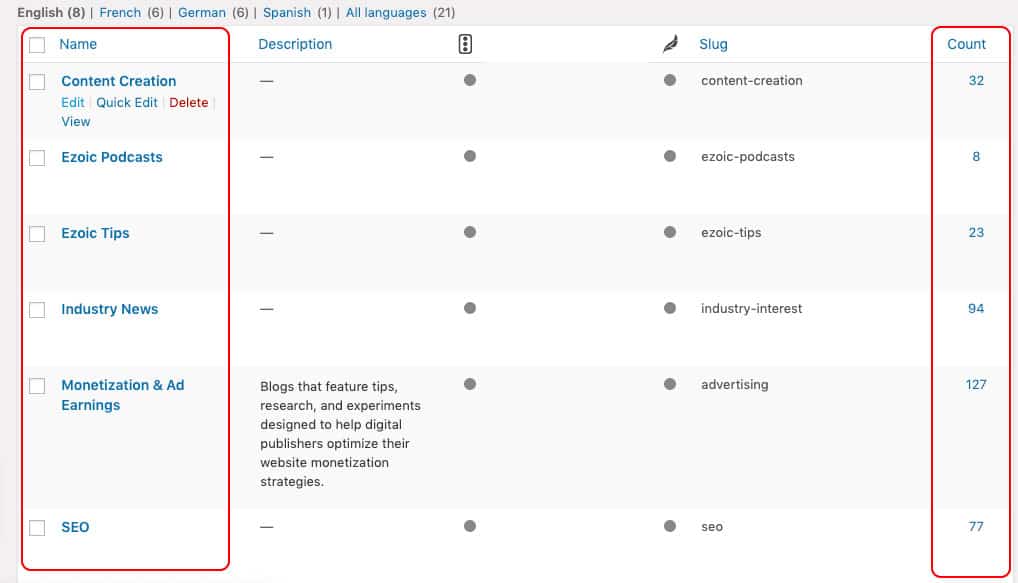
Once these categories are established, you’ll have the category name and the count of how many pieces of content exist within that category. This “count” of the articles within the respective categories will be an important part of how to use Ezoic’s Big Data Analytics to look at your content and website growth more holistically.
How do I use Categories to optimize my site with Ezoic?
Once you’ve set up categories on your CMS, you can view your ad revenue by category on Ezoic’s Big Data Analytics.
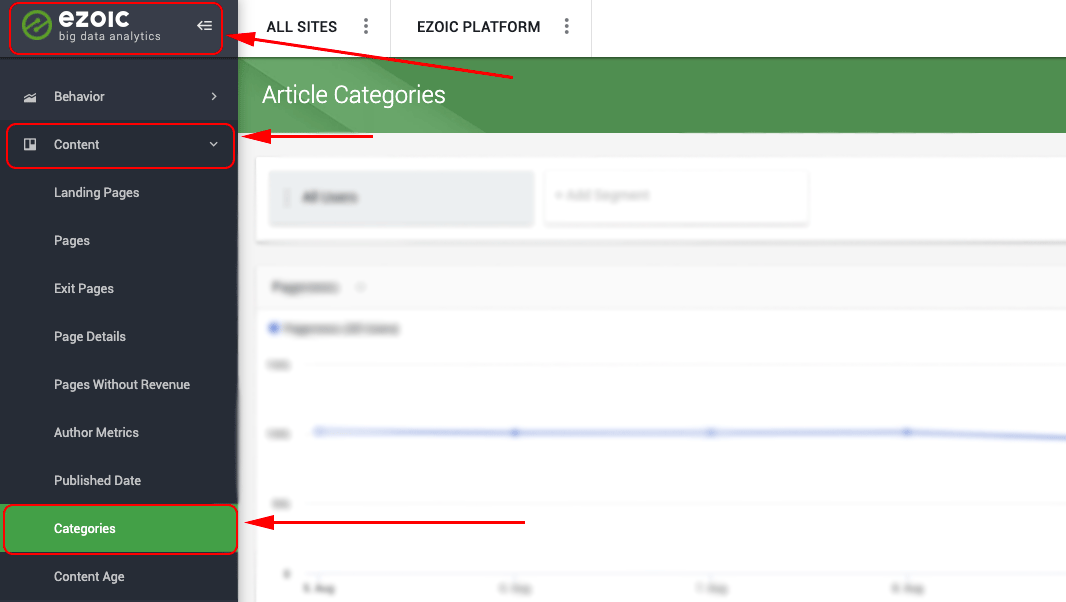
The “categories” tab on Ezoic’s Big Data Analytics is housed within the “Content” drop-down tab. There, you will see revenue broken down by the article categories you have set up on your CMS.
If you don’t have categories set up on your site, don’t fret. Although depending on how much content you currently have on your site, it can seem daunting to re-visit all your content retroactively to add your existing articles to the newly-created categories.
Luckily, if you use WordPress, the “quick edit” option within your articles can allow you to streamline the process of assigning categories to your already-published content.

The value you will gain by being able to see your site revenue broken down by article category if you’re using Ezoic’s Big Data Analytics is worth the time spent to create categories. Below, I’ll show you why.
How does data from Categories help make better decisions?
When you have categories correctly set up on your CMS, being able to view your EPMV (Earnings per thousand visitors) by article category gives you a more granular look at both your revenues and the performance of your content.
Let’s take this example of a fishing blog that has categories set up on their site. Here is a look at their earnings by category on Big Data Analytics.

You can see that “Bass Fishing” accounts for 44.49% of the total site revenue, and also accounts for the highest percentage of articles created as well (17.15%).
But, if you look at the EPMV by article category you see that “Fly Fishing” has the highest EPMV by far of all the categories. What’s more is that the “Average Page Engaged Time” is 1 minute and 11 seconds, a good 20 seconds longer than the majority of the other categories.
What we know for certain from this data is that:
- Visitors are spending on average 20 seconds longer on Fly Fishing articles than any other category
- The earnings per thousand visitors are at least 85 cents higher than any other article category.
If you were this publisher trying to grow your website and increase ad revenues, this type of data is paramount to your future content strategy. You now know that while fly fishing only accounts for 10.42% of the total articles on the site, that percentage can increase in time as new content about Fly Fishing is created.
With Fly Fishing’s engagement time and EPMV significantly higher than all the other categories on the site, we can presume that if a lot of new content is created within that category, site revenue will increase.
Will Categories help grow my website?
When used strategically with Ezoic’s Big Data Analytics, yes. The previous example’s data demonstrates the potential of growing your site by adjusting your content strategy based upon what the data is pointing to.
Even if you’re retroactively creating categories and adding articles to certain categories, new visitors are always coming to your site. This new data will be constantly feeding into your Big Data Analytics, so check your categories data fairly frequently.
Big Data Analytics gives you the ability to see the data from last week, last month, last 7 days, and last 30 days. You can also input a custom range.
Another function of Big Data Analytics is custom segmenting.
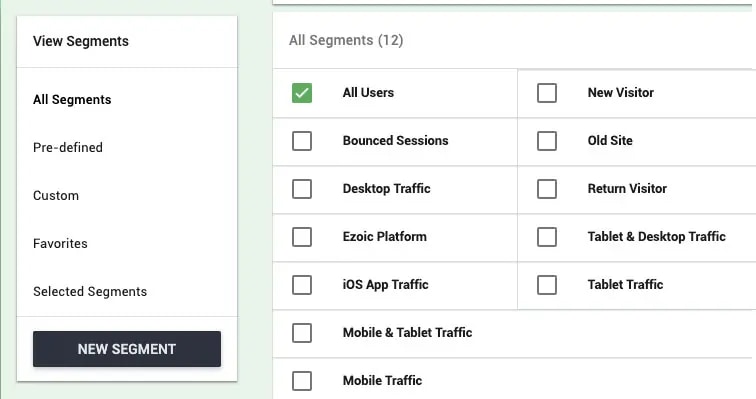
You have the ability to segment visitor traffic by desktop, mobile, and traffic, new visitor, old visitor, and more. This feature creates the potential to give you an even more granular look into your site’s traffic and revenue.
What other functions does data from Categories have?
The first additional function categories have is that, simply put, they are helpful to your site visitors. If you were an avid fisher and you wanted to read all of a site’s articles about ice fishing, would you rather have to type “ice fishing” in the search input to find all the content related to that search? Or would you prefer to click a button that brings you to all the content created under the ice fishing category?
The latter is more efficient, and having categories on your site both organizes your content for your own (analytical) benefit along with the improved user experience for those navigating your content.
SearchEngineJournal says the best way to approach implementing categories on your site is:
- Define them carefully
- Choose nomenclature that is inclusive rather than exclusive
- Provide a summary or description of what’s in each category.
Along with organizing your site’s content, coupling categories with Ezoic’s Big Data Analytics can be a powerful tool to inform a publisher’s current and future content strategy. Do you use meta tags or categories on your site? Let us know in the comments.

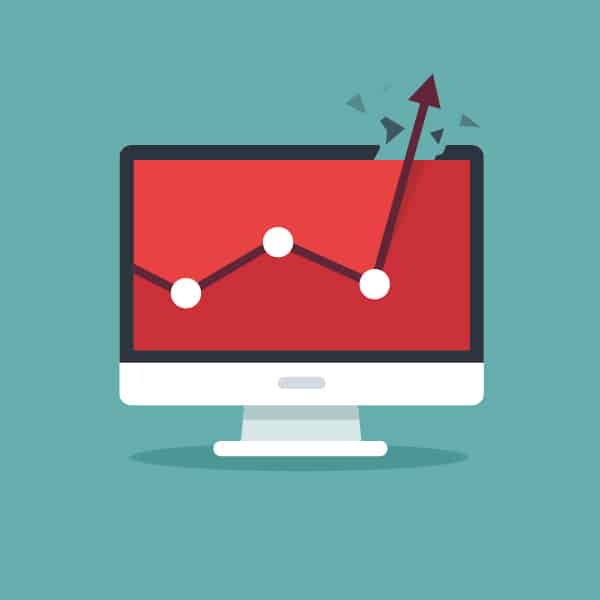
This is great content Allen. I am a Ezoic publisher and I categorize my site. However, I’ve not been making the utmost use of the Ezoic Big Data Analytics.
I use the EBDA to check revenue by country and also see articles generating the highest revenue.
I was interested in this topic cos of a new prompt on my Ezoic dashboard seeking permission to my analytics to access some information that will help me increase revenue using the categories section from the dashboard.
And the article gave justice to my query.
One thing I’ve not done well is having the same description for all my categories. Will change this immediately and be more specific about the categories.
Thanks once again Allen.
Ezoic rocks.
This is great content Allen. I am a Ezoic publisher and I categorize my site. However, I’ve not been making the utmost use of the Ezoic Big Data Analytics.
I use the EBDA to check revenue by country and also see articles generating the highest revenue.
I was interested in this topic cos of a new prompt on my Ezoic dashboard seeking permission to my analytics to access some information that will help me increase revenue using the categories section from the dashboard.
And the article gave justice to my query.
One thing I’ve not done well is having the same description for all my categories. Will change this immediately and be more specific about the categories.
Thanks once again Allen.
Ezoic rocks.
Nice guidance… Thanks a lot. Before it I ignored this category section, but not now…☺️
Nice guidance… Thanks a lot. Before it I ignored this category section, but not now…☺️
Hi Allen, Yeah..! We use meta tags and category but I don’t know much about it I have just gone through the meaning of it and I know we use it 😉 from your article I came to know what it is and why we use it… Thanks for sharing the informative post. Surely I will come back here to learn many things from your blog related to SEO.
Hi Allen, Yeah..! We use meta tags and category but I don’t know much about it I have just gone through the meaning of it and I know we use it 😉 from your article I came to know what it is and why we use it… Thanks for sharing the informative post. Surely I will come back here to learn many things from your blog related to SEO.
Thanks for clarifying the importance of tags, categories, and viewport functionality. I was following a very old tutorial where it was advised to use tags for posts using Yoast, which led me to over-optimization. I found your post from FB ad and after reading it I am going to do necessary changes to my blog.
As I am using WordPress for my blog, is it still necessary to use the viewport code on my site? I have heard that it was only for static website. WordPress does it automatically. Any kind of help would be very much appreciated. I have just started my first blog.
Thanks for clarifying the importance of tags, categories, and viewport functionality. I was following a very old tutorial where it was advised to use tags for posts using Yoast, which led me to over-optimization. I found your post from FB ad and after reading it I am going to do necessary changes to my blog.
As I am using WordPress for my blog, is it still necessary to use the viewport code on my site? I have heard that it was only for static website. WordPress does it automatically. Any kind of help would be very much appreciated. I have just started my first blog.
No, started blogging, it’s not necessary. If you are using WordPress, the viewport code should automatically be in your code. Before tinkering with the code on the backend, you can view the code on WordPress and use the CTRL + F function to search and see if the code exists already. Reference the photos within this article to see if the viewport code exists on your site as well. Although since you’re already using WordPress, you should already be set. Double-checking never hurts, though!
No, started blogging, it’s not necessary. If you are using WordPress, the viewport code should automatically be in your code. Before tinkering with the code on the backend, you can view the code on WordPress and use the CTRL + F function to search and see if the code exists already. Reference the photos within this article to see if the viewport code exists on your site as well. Although since you’re already using WordPress, you should already be set. Double-checking never hurts, though!
You’re very welcome, Mercy! I’m glad you liked the article. We have lots of articles related to SEO as well. Knowledge is power!
You’re very welcome, Mercy! I’m glad you liked the article. We have lots of articles related to SEO as well. Knowledge is power!
You’re welcome, Abhijit!
You’re welcome, Abhijit!
The data sure does speak for itself, doesn’t it? It’s a smart move that you’re starting to use categories with Big Data Analytics. Not only in the present, but in the future as you publish new content. Thanks for the kind words, Francis. You rock!
The data sure does speak for itself, doesn’t it? It’s a smart move that you’re starting to use categories with Big Data Analytics. Not only in the present, but in the future as you publish new content. Thanks for the kind words, Francis. You rock!
Great article, I was unaware of how much data was available in the Big Data Analytics feature. I will now be checking out all my sites to know what categories I should get content written in.
Great article, I was unaware of how much data was available in the Big Data Analytics feature. I will now be checking out all my sites to know what categories I should get content written in.
Thanks Allen. I have categories defined on all my websites, but 40% of my visit are identified as “(unknown)” category. Which exact HTML field is Ezoic using to detect the category? I am using not using WordPress.
Thanks Allen. I have categories defined on all my websites, but 40% of my visit are identified as “(unknown)” category. Which exact HTML field is Ezoic using to detect the category? I am using not using WordPress.